Edie Melson's Blog, page 127
May 7, 2022
Springing into a New Day

by Martin Wiles @LinesFromGod
After twenty-seven years, he walked out as a free man.
Nelson Mandela became the president of the African National Council in 1952. The ANC embodied South Africa’s nationalized resistance movement against apartheid—the institutionalized system of white supremacy and racial segregation.
In 1961, authorities arrested him for treason. Acquittal followed soon thereafter, but authorities arrested him again the next year for illegally leaving the country. The courts sentenced him to five years at Robben Island Prison. In 1964, authorities charged him with sabotage and sentenced him to life in prison.
Mandela spent eighteen years at Robben Island where he was confined to a small cell with no bed or plumbing. Guards forced him to do hard labor in the quarry. He could write and receive a letter only once every six months, and once a year, they allowed him to meet with a visitor for thirty minutes.
Yet, Mandela’s resolve remained. He led a movement of civil disobedience that eventually convinced South African officials to improve prison conditions. In 1989, F. W. de Klerk became South Africa’s president and began to dismantle apartheid. On February 11, 1990, he ordered Mandela’s release. Mandela took off his prison garb and put on his regular clothes.
Former King Jehoiachin also put on some new clothes. “He (Evil-merodach) supplied Jehoiachin with new clothes to replace his prison garb and allowed him to dine in the king’s presence for the rest of his life” (Jeremiah 52:33 NLT).
A previous Babylonian king had removed him from his throne in Jerusalem and taken him captive. But now a new king freed him. Not only did Jehoiachin take off his prison garb, but he also ate regularly at the king’s table.
Spring brings with it new clothes as well. Dormant trees bud, flower, and then leaf out. The grass greens. The dreaded pollen covers everything. Birds that left during the winter return to feeders and nest in trees. Perennials peak their heads from beneath a warming soil. And seeds in our flower and vegetable gardens sprout and provide us with beauty and fruit.
Spring can also bring renewal for writers. The cold, dreary months of winter often threaten to zap our creativity. Some suffer from SAD (Season Affective Disorder) and struggle just to make it through the day, must less put anything on paper. Everyone, including publishers and agents, seem to take a vacation. We long for opportunities, but few come. With spring, our mindsets take a brighter turn. Closed doors suddenly open. We don’t feel washed up anymore. We actually think someone might want to read what we have written.
In a spiritual way, God replicates spring for us when we seek forgiveness. Prior to this time, we wear sin garb, but forgiveness ushers us into new clothes: the righteousness of Christ. God then welcomes us to his table of grace, and we can freely come as often as we desire.
But our spring benefits extend beyond earth. In heaven, we will sit at the feasting table of the King, dining with him for eternity.
The Bible doesn’t tell us how Jehoiachin reacted to his new set of circumstances, but we can imagine. Even eating with a pagan king after being imprisoned must have exhilarated him.
And us? When God opens new writing doors we didn’t even knock on or ones we’ve tired of knocking on, we, too, can rejoice, thank him, and do our best to use the skills he’s given us.
Why not take a moment to thank God for the new garb he’s given you? Then, spring into the new day God has made.
TWEETABLESpringing into a New Day, insight from Martin Wiles, @LinesFromGod on @EdieMelson (Click to Tweet)
 Martin Wiles is the founder of Love Lines from God (www.lovelinesfromgod.com) and serves as Managing Editor for Christian Devotions, Senior Editor for Inspire a Fire, and Proof Editor for Courier Publishing. He has authored six books and has been published in numerous publications. His most recent book, DON'T JUST LIVE...REALLY LIVE, debuted in October of 2021. He is a freelance editor, English teacher, author, and pastor.
Martin Wiles is the founder of Love Lines from God (www.lovelinesfromgod.com) and serves as Managing Editor for Christian Devotions, Senior Editor for Inspire a Fire, and Proof Editor for Courier Publishing. He has authored six books and has been published in numerous publications. His most recent book, DON'T JUST LIVE...REALLY LIVE, debuted in October of 2021. He is a freelance editor, English teacher, author, and pastor.
Published on May 07, 2022 22:00
May 6, 2022
Don’t Miss God’s Good in Your Writing
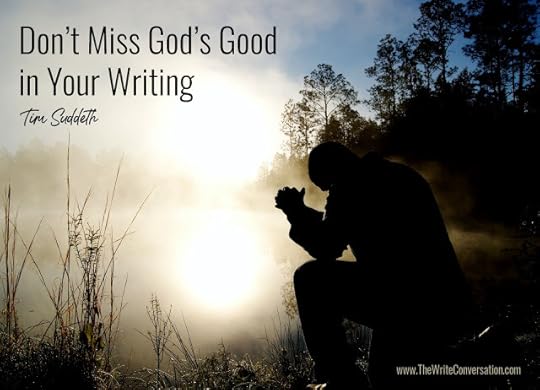
By Tim Suddeth @TimSuddeth
Life and writing are similar in that both have their ups and downs. I love the ups. The downs, not so much. But it’s in the down times where we learn the most.
Since we do so much of writing in solitude, it’s easy for obstacles or perceived problems to become exaggerated in our minds. The same creativity that helps us when we face a blank page or screen can be our undoing when we run into reality.
There is a popular saying that says when the going gets tough, the tough get going.
I hate that saying. When my going gets tough, I want to break for ice cream. Because, truly, I’m not all that tough. When the Lord leads me through the Valley of the Shadow of Death, I look for a detour sign. Except there is no detour. And there is no way to get through life, or to write, without running into hardship.
And life’s hardships are no joke. A call from the oncologist, a pink slip when your child gets accepted to their dream college. A broken relationship. Fill in your own blank. No one gets through life unscathed. Or unscarred.
Recently, I discovered a new way to look at hardship while I was reading through the Book of Jeremiah. Now, Jeremiah will never be mistaken for a self-help guru. He is rightly known as the weeping prophet because much of his message is foretelling the fall of his city and country. However, there was one nugget in one of his letters that caught my eye.
Jerusalem had fallen, and Nebuchadnezzar had carried many of its citizens off into exile. Then Jeremiah sent a letter to the king of Babylon saying that his kingdom would soon fall. Not the way to build your platform.
But while Jeremy was delivering God’s message of defeat, another prophet, Shemaiah, sent a letter saying that the priest should put Jeremiah into the stock and neck-irons. In Jeremiah 29, we see God’s opinion of someone who preaches rebellion against the Lord.
Verse 32 shows two ways God would punish the false prophet. First, God said “he would not have anyone living among this people.”
Second, and the one that caught my eye, “He shall not see the good that I am about to do to my people.” Even though His people were in exile, their city destroyed, and their promised land taken, God had not finished with them.
God has a plan for each of us. He says so throughout His scriptures. And, usually, His plans involve some sort of hardship. As much as I cringe from hardships, it terrifies me to think that I might miss the good He plans to work through me because of a temporary hardship. He is greater than any trial I could ever face.
Again, I’m not minimizing what any of us are going through. Many of us face adversity that I can’t imagine. But in God’s eyes, they are all temporary. The fruition of His incredible plan has yet to be seen.
It is the people who realize this, who soldier through while carrying incredible burdens, who become the role models for the rest of us. Their lives show us how to act when our time comes. As it will.
So, let’s adjust the saying about the tough get going. Instead of putting the emphasis on our toughness, or lack thereof, the truth is more that when the going gets tough, His children are encountering His plan. And that is right where He wants us.
TWEETABLEDon’t Miss God’s Good in Your Writing, insight from @timsuddeth on @ediemelson (Click to tweet)
 Tim Suddeth is a stay-at-home dad and butler for his wonderful, adult son with autism. He has written numerous blogs posts, short stories, and three novels waiting for publication. He is a frequent attendee at writers’ conferences, including the Blue Ridge Mountain Christian Writers Conference and a member of Word Weavers and ACFW. He lives near Greenville, SC where he shares a house with a bossy Shorky and three too-curious Persians. You can find him on Facebook and Twitter, as well as at www.timingreenville.com and www.openingamystery.com.
Tim Suddeth is a stay-at-home dad and butler for his wonderful, adult son with autism. He has written numerous blogs posts, short stories, and three novels waiting for publication. He is a frequent attendee at writers’ conferences, including the Blue Ridge Mountain Christian Writers Conference and a member of Word Weavers and ACFW. He lives near Greenville, SC where he shares a house with a bossy Shorky and three too-curious Persians. You can find him on Facebook and Twitter, as well as at www.timingreenville.com and www.openingamystery.com.Featured Image: Photo by Aaron Burden on Unsplash
Published on May 06, 2022 22:00
May 5, 2022
Writing an Un-Put-Downable Character (Part 4 of 10): History

by A.C. Williams @ACW_author
Can you imagine Sherlock Holmes without his addictions? What about Elizabeth Bennet without the outrageous antics of her family?
Would you get Frodo in the Lord of the Rings without first knowing about the Shire? Or what about the Pevensie children and life in war-torn England before they arrive in Narnia?
Last month in our series about creating un-put-downable characters, we talked about Contradictions. Today, we’re talking about History.
Where did your character come from? What about nationality, culture, and religion? What job did they work? What skills do they have?
Did they grow up on the street or in a posh boarding school? Are they the child of nobles, or are they the unwanted orphan forced to live in the cupboard under the stairs?
As an author, one of the most powerful resources at your disposal is your character’s History. Sometimes we call it back story, and there are more rules on how you use it than you can shake a stick at. But regardless of how, when, where, and why you use it, you gotta have it.
How Darth Vader Hooked Us
In 1977, when the shadowy figure of Darth Vader appeared on movie screens across the country, nobody knew who he was or where he came from. Obviously, he was a villain. We’d learn later in the film that he was once the student of Obi-Wan Kenobi (my personal favorite) and had turned against everything he’d been taught. We’re told he murdered Anakin Skywalker. We know he’s powerful, unhinged, and that just about everyone is utterly terrified of him because of his superhuman powers.
We know the basics. Vader had been a noble Jedi once, and he’d fallen to the Dark Side of the Force. For this movie, that’s all we need. He’s the bad guy. But he leaves us with questions.
If he wasn’t always evil, why did he turn? If Darth Vader is so strong, why does he obey the emperor? Why does he wear that freaky looking suit? Does he need the respirator to breathe? If so, what happened to him to cause it?
We’ve got questions, y’all.
This is why you develop a character’s back story. Your readers need enough information about your character to satisfy the needs of the immediate story, but if you indicate there’s more to discover, they’ll keep coming back.
When you as the author know all these extraneous details, it allows you to write your character as a fully rounded individual with quirks, eccentricities, and compelling depth that leads readers to ask WHY.
There’s a reason why Darth Vader serves the emperor. There’s a reason why Vader can’t survive outside his suit. There’s a reason why he hates Obi-Wan Kenobi. But none of those reasons add to the story of the original Star Wars movie. If the writers were to pursue those reasons, it would have distracted from the main point.
Introduce Luke Skywalker, the hero. Rescue the princess. Save the Rebellion. That’s the main story of the first Star Wars movie, and anything that distracted from that main point would have muddied the waters (and with all the names, alien races, and flailing facial prosthetics, it was hard enough to keep track of everything anyway).
But that one movie released 45 years ago this month launched a literal empire of movies, books, and television shows that’s still going strong today (Baby Yoda anyone?).
Sure, the effects were impressive for the time. No, it had never really been done before. But it wasn’t the effects or the concept that sold audiences worldwide on Star Wars. It was the characters, and it was the fact that as deep as you wanted to dig into their histories, you could. The world was so fully rounded that even the side characters had histories (hello, Boba Fett).
What We Can Learn From Star Wars
Give your characters back story. Make it deep. Build it into how they speak, what they look like, what they wear, what they eat. Don’t be satisfied with “they just do” as an answer for why a character does something. Connect it to some element of their history.
Why they do it always matters more than What they do.
Let’s say your protagonist has a facial scar. Maybe for the story you’re writing right now, it doesn’t matter where it came from. But you need to know. What if he got it from a house fire that killed his family? Maybe he’s the only survivor.
For this story, that fact may not matter, but if that’s the case, that character will have certain reactions to fire and the smell of smoke. He’s going to experience trauma. He’ll have other characteristics of someone who has survived something like that.
We don’t need to know who died or when or where. We may not even need to know it happened. But your character knows, and that knowledge shapes how he reacts to other elements in the story. So you need to know too.
Give your characters a history. You may not need to put it in the book you’re writing, but it will have a huge affect on how you write.
For your information, here’s what’s left in our ten-step journey:
Personality Conflict Contradictions History Interests Language Internalization Dreams Observables Growth
TWEETABLEWriting an Un-Put-Downable Character: History - insight & tips from @ACW_Author on @EdieMelson (Click to Tweet)
Don't Miss the Other Posts in This SeriesPART 1 PERSONALITY: WRITING THE UN-PUT-DOWNABLE CHARACTER PART 2 CONFLICT: WRITING THE UN-PUT-DOWNABLE CHARACTER PART 3 CONTRADICTION: WRITING THE UN-PUT-DOWNABLE CHARACTERPart 4 HISTORY: WRITING THE UN-PUT-DOWNABLE CHARACTER
 Award-winning author, A.C. Williams is a coffee-drinking, sushi-eating, story-telling nerd who loves cats, country living, and all things Japanese. She’d rather be barefoot, and if she isn’t, her socks won’t match. She has authored eight novels, two novellas, three devotional books, and more flash fiction than you can shake a stick at. A senior partner at the award-winning Uncommon Universes Press, she is passionate about stories and the authors who write them. Learn more about her book coaching and follow her adventures online at https://www.amycwilliams.com.
Award-winning author, A.C. Williams is a coffee-drinking, sushi-eating, story-telling nerd who loves cats, country living, and all things Japanese. She’d rather be barefoot, and if she isn’t, her socks won’t match. She has authored eight novels, two novellas, three devotional books, and more flash fiction than you can shake a stick at. A senior partner at the award-winning Uncommon Universes Press, she is passionate about stories and the authors who write them. Learn more about her book coaching and follow her adventures online at https://www.amycwilliams.com.
Published on May 05, 2022 22:00
May 4, 2022
The Writer's Life: Saying Goodbye to Characters You Love

by Lynn H. Blackburn @LynnHBlackburn
It’s been a weird month in my head.
Why?
Because I’m saying goodbye to characters who have held the top spot in my brain for years. And I’m saying hello to entirely new characters who are just starting to form in my mind.
Last month, I turned in the final book of my Defend and Protect series . That particular story world lays claim to three novels, three novellas, and over three years of my life.
It feels a lot like it did when we moved away from a town we’d lived in for three years. We knew when we moved that we would someday have to say goodbye to the friends we made, the restaurants we enjoyed, the house we’d made our own. But even knowing that day would come, it didn’t make it any easier to drive away.
I moved several times as a kid, so my adult brain already knew what would happen in our new home. For a while, it would be strange. I’d have to look up directions to get anywhere. I’d have to learn my way around, find a new favorite grocery store, discover new restaurants, and visit new churches. I’d have to figure out new TV channels and change the presets in my car to new radio stations.
And I’d make new friends.
Y’all. Making new friends? I don’t know how that goes for you, but for me? That’s hard. It makes me cringe just thinking about it. Because the new people at work, church, school, the gym, the neighborhood—they were all perfectly lovely.
But they were strangers. I didn’t know anything about them. I had to memorize their names, remember who was married to who, which kids went with which parents, who had a great marriage, who had been divorced three times, whose parents were amazing and who had in-laws out of a nightmare.
None of that happened overnight. It took time for me to remember who had what job, which college they’d gone to, if they were sports fans or theater fans or movie fans.
And it took even longer to uncover the parts of themselves that weren’t so obvious but that were important to who they were. The unhappy childhoods, the miscarriages, the work stress, the abuse, the addictions, the dreams unfulfilled, and the fears that kept them up at night.
Which is why my brain is a very strange place right now. Because finishing a series and starting a new one is so much like moving to a new town.
Part of me is sad. It’s hard to say goodbye to friends—even when those friends are fictional characters that I made up and then put through all sorts of drama. Come to think of it, those friends might be happy to see me go! I imagine them thinking, “Finally we can get some peace around here!”
The other part of me is cautiously optimistic. I’ve done this before. I know I won’t feel comfortable here for a while, but I know it will happen eventually.
My new characters have names, for the most part. Not that I can remember all of them yet. They have professions, although a few of them have changed rather dramatically over the past few weeks.
As I’ve given these new people residence in my mind, they’ve started to reveal themselves. I’m learning what makes them tick—who has a soft spot for kids, who has never met an animal they didn’t want to take home with them, and who has zero tolerance for bullies.
There’s a restaurant in my new town that is beloved by the locals. There’s a church that has some serious issues because Christians aren’t always Christ-like. There’s a creek that acts as a property line that’s going to be very important. And the other day I discovered a rail-to-trail bike path that has driven tourists to the area, much to the dismay of some of the locals, and the delight of others.
Even though I know it’s temporary, I think I’m going to like my new creative home. And in a few years when I have to say goodbye, I’ll be both sad and cautiously optimistic, because as scary as it is to make new friends, it’s so worth it.
So how about you? Have you created a new world? What did it feel like? How did you manage the transition?
And if you’re a nonfiction writer—it’s okay to be a little freaked out about how I described this. I told you my brain was a weird place!
Grace and peace,

TWEETABLEThe Writer's Life: Saying Goodbye to Characters You Love, insight from @LynnHBlackburn on @EdieMelson (Click to Tweet)
 Lynn H. Blackburn loves writing romantic suspense because her childhood fantasy was to become a spy, but her grown-up reality is that she's a huge chicken and would have been caught on her first mission. She prefers to live vicariously through her characters and loves putting them into all kinds of terrifying situations while she's sitting at home safe and sound in her pajamas!
Lynn H. Blackburn loves writing romantic suspense because her childhood fantasy was to become a spy, but her grown-up reality is that she's a huge chicken and would have been caught on her first mission. She prefers to live vicariously through her characters and loves putting them into all kinds of terrifying situations while she's sitting at home safe and sound in her pajamas! Unknown Threat, the first book in her Defend and Protect series, was a 2021 Christy Award finalist and her previous titles have won the Carol Award, the Selah Award, and the Faith, Hope, and Love Reader’s Choice Award. Malicious Intent, the second book in the series, released March 2022.
She is a frequent conference speaker and has taught writers all over the country. Lynn lives in South Carolina with her true love and their three children. You can follow her real life happily ever after by signing up for her newsletter at LYNNHBLACKBURN.COM and @LynnHBlackburn on BOOKBUB, FACEBOOK, TWITTER, PINTEREST, and INSTAGRAM.
Featured Image: Photo by Daoudi Aissa on Unsplash
Published on May 04, 2022 22:00
May 3, 2022
Graphic Novels: A “New” Way to Tell a Story?

by Sarah Sally Hamer @SarahSallyHamer
What exactly is a Graphic Novel? Honestly, it’s just a story told with mostly pictures. Words are definitely important, of course, but they are not the main way of telling the story in a GN. In a lot of ways, children’s books—up through chapter books—are all a form of GNs, since illustrations are used to help tell the story to non- or early readers. But pictures have always been a great way of telling any story, to any audience.
GNs open a whole new way to tell any kind of story to every age. I don’t believe they will ever completely replace books with only words, but a new, visually-connected audience is out there, just waiting to be engaged in story.
So, how do we write them?
Since we’re not using just words, it can be a little different for a writer of only words to wrap their head around. But we’re still just telling a story. I suggest you create three versions of each scene, with the aspects you’ll need:PlotWordsIllustrations or illustration ideas
Each of these elements can be visualized on a storyboard, frame by frame. Storyboards have been around for a century or so, most often used in the film industry, but they’re very useful in any type of writing. When first creating a story, storyboarding is immensely basic. Spending a lot of time with picture details until you get the story straight can be a waste and may even cause you to limit your ideas because you’ve put a lot of work into it. Instead, we want to be unlimited, at least in the first draft, so we can really figure out what goes in and what gets thrown away.
Important things:A storyboard is usually a rough outlineEach picture should tell an important moment in the storyBe open to where the story may decide to go but don’t follow too many rabbit trailsAdd details as you think about them but recognize you may have to go back for moreWrite tight. You do NOT have the room to expound. Each word has to earn its placeIf you need to figure something out, it’s perfectly all right to go back to your computer and actually write a scene, then insert the concept into the storyboardI create a template page that looks like this:
Plot
Words
Illustration ideas
Frame#1
Frame #2
Frame #3
As you see, each frame (the building blocks of a graphic novel) has a place marker where the writer can insert the important pieces. So, when you visualize your story, you can put information into each block as you think of it. For instance, stories need plot—my favorite version is The Hero’s Journey—where we know what happens next. I start with an inciting incident (Call to Adventure) and go from there. I may not know exactly what happens next but I can jump around as the story unfolds.
These blocks can (and probably should) be expanded to separate pages. Here’s my version, which I print, punch holes in, and put as many pages as I think I’ll need into a binder then, as I work through the story, I add pages in or take pages out or move pages around as I go.

This way, you have the ability to write down what you know you need at any given point, with words and illustration ideas as you go.
My “Words” section is very concise, because I now have a picture to aid my story. I may write an entire sentence in the first draft—or more if I need it!—but when the book is done, each frame will have minimal words in it. Since I am not artistic, at least on canvas, my illustrations consist of stick people – or just a description that an illustrator may use to create something fabulous. (If you too need aid for that side of it, you can hire illustrators on the internet. Just be sure of what you’re asking for and what you’re getting.)
When I was doing research for this article, I found a company that produces Christian Fiction Graphic Novels. Some of the fiction stories are taken directly from the Bible, and some are modern versions of Biblical stories. This particular company also prints a GN version of both the Old and New Testaments, which I think is most interesting.
Non-fiction GN books are also available, including memoirs, so, if you’re interested, I recommend that you look into the vast array of possibilities. After all, we’re all telling stories!
TWEETABLEGraphic Novels: A “New” Way to Tell a Story? Tips & Insight from @SarahSallyHamer on @EdieMelson (Click to Tweet)
 Sarah (Sally) Hamer, BS, MLA, is a lover of books, a teacher of writers, and a believer in a good story. Most of all, she is eternally fascinated by people and how they 'tick'. She’s passionate about helping people tell their own stories, whether through fiction or through memoir. Writing in many genres—mystery, science fiction, fantasy, romance, medieval history, non-fiction—she has won awards at both local and national levels, including two Golden Heart finals.
Sarah (Sally) Hamer, BS, MLA, is a lover of books, a teacher of writers, and a believer in a good story. Most of all, she is eternally fascinated by people and how they 'tick'. She’s passionate about helping people tell their own stories, whether through fiction or through memoir. Writing in many genres—mystery, science fiction, fantasy, romance, medieval history, non-fiction—she has won awards at both local and national levels, including two Golden Heart finals.A teacher of memoir, beginning and advanced creative fiction writing, and screenwriting at Louisiana State University in Shreveport for almost twenty years, she also teaches online for Margie Lawson at WWW.MARGIELAWSON.COM. Sally is a freelance editor and book coach at Touch Not the Cat Books, with many of her students and clients becoming successful, award-winning authors.
You can find her at hamerse@bellsouth.net or WWW.SALLYHAMER.BLOGSPOT.COM
From Sally: I wish to express gratitude to the giants upon whose shoulders I stand and who taught me so much about the writing craft. I would list every one, if it were only possible.
Featured Image: Photo by Sigmund on Unsplash
Published on May 03, 2022 22:00
May 2, 2022
Writing Adversaries, Antagonists And Other Villains
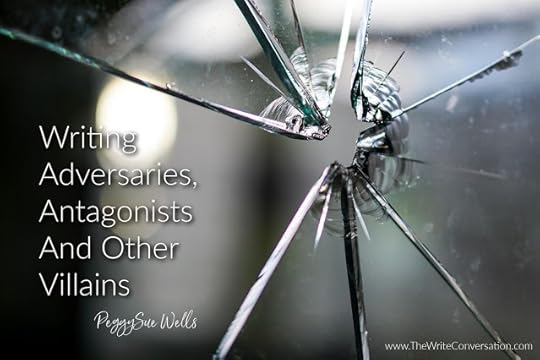
by PeggySue Wells @PeggySueWells
“Contains one of the best well-rounded villains I have read in a long time,” reviewed Joseph Dyer about my book, The Patent.
This remains one of my favorite reviews because this reader recognized the multi-dimensions of the antagonist.
Story consists of three elementsA character we care aboutThe character’s great needA great obstacle between the character we care about and their great need.Frequently, the great obstacle is the antagonist, who can also be referred to as adversary, competitor, enemy, opponent, rival, or villain. Memorable antagonists includeClaudius in HamletDarth Vader in Star WarsFernand Mondego in Count of Monte CristoProfessor James Moriarty in Sherlock HolmesSheriff of Nottingham in Robin HoodVoldemort in Harry PotterAt its core, character is the organization and structure of a person’s character or personality. Stories commonly feature a character line-up including protagonist, sidekick, antagonist, and mentor. In the same way a protagonist has flaws and weaknesses, an antagonist is not all bad.
Protagonists and Super Heroes have flaws and weakness. In his youthful immaturity, Thor lost his father’s trust. When possible, entwine the hero with the antagonist. Thor is at war with his brother. In the same way the protagonist is not perfect, neither is an antagonist all bad. We kinda like Loki, at least as played by Tom Hiddleston.
Well-developed antagonists have a backstory. Once we realize the Wizard of Oz is as lost as Dorothy, we have insight into the motivation that drives his actions. In my novel, The Patent, Colonel Jai Yao is motivated by a desire to improve life for his countrymen. While we see Yao threaten our hero, we are also privy to the choices he made to provide care for his frail parents. Like Javert in Les Miserables, Yao didn’t set out to be evil on purpose. In the end, the reader and Yao are certain that even good motivations are no excuse for becoming a monster.
Story is conflict, and conflict is multi-dimensional. In addition to the friction between the hero and the antagonist, both characters are challenged by the tensions within their own personalities. In Beauty and the Beast, the Beast begins as the dangerous antagonist and transforms into Belle’s happily ever after. That transformation is believable because the reader learns the reasons behind his circumstances and has sympathy for this character who is misunderstood, misjudged, and in a scenario he brought on himself through the common human traits of selfishness and pride.
Similarly, the Grinch begins as the evil protagonist of his own story, and experiences a character arc that ends with his transformation into a good character. Occasionally, as with Alex and A Clockwork Orange, the evil protagonist remains unredeemed. Antagonists can be human or inanimate including prejudice in Pride and Prejudiceweather in Chasing Sunrisemedical in WonderSuspense grows when the antagonist is a worthy opponent, and the opponent is worthy when we believe there is a good chance the protagonist will lose. For instance, in The Sound of Music, the German officer, backed by Hitler, is a worthy opponent to the Von Trapp family.Herod’s cruelty made him a frightening opponent for Mary, Joseph, and baby Jesus.The British Empire proved to be a mighty opponent during the Revolution as George Washington’s rag tag soldiers fought for liberty.Captain America fought Captain America— “I can do this all day.” —when he went back in time to face himself in a desperate attempt to reverse the Thanos snap.In Moby Dick, the adversarial great white whale does win in the end. Or is Captain Ahab the real villain in the story?
The clash between two opposing forces creates the narrative thread that spins into story. When two characters want the same single item, there can be only one Super Bowl trophy in the yearly play offhusband for Belle in Beauty and the Beastone throne to rule the kingdom in Game of Thrones one ring of power in Lord of the Ringsone owner of the litter of puppies 101 DalmatiansAntagonists that vie against our character we care about can look likeself: In Jack London’s Call of the Wild, the hero wrestles himself for transformationGod: Jonah attempts to weasel away from God’s instructionsdestiny: They Both Die at the End lets readers know the destiny of each charactercharacter: Three Musketeers versus evil monarchs environment: Santiago in The Old Man and the Seasociety or culture: Hester Prynne in Scarlet Lettermachine: 2001 A Space Odyssey pits characters against the artificial intelligence, HALsituation or circumstance: A schoolmaster develops a horse into the foundation of the Morgan breed in Justin Morgan Had A Horsethe unknown: Ender’s Game is leaders taking action without clear understanding of what they faceAs you create an antagonist for your story, consider these questions.
What motivates the antagonist?
What is your antagonist most afraid of?
In what ways is your antagonist misjudged and misunderstood?
How does your antagonist bring out the best in your hero?
How does your antagonist bring out the worst in your hero?
How is your protagonist and antagonist connected?
What’s the worst that can happen to the antagonist?
TWEETABLEWriting Adversaries, Antagonists And Other Villains, tips from @PeggySueWells on @EdieMelson (Click to Tweet)
 Tropical island votary and history buff, PeggySue Wells parasails, skydives, snorkels, scuba dives, and has taken (but not passed) pilot training. Writing from the 100-Acre Wood in Indiana, Wells is the bestselling author of thirty books including The Slave Across the Street, Slavery in the Land of the Free, Bonding With Your Child Through Boundaries, Homeless for the Holidays, Chasing Sunrise, and The Ten Best Decisions A Single Mom Can Make. Founder of SingleMomCircle.com, PeggySue is named for the Buddy Holly song with the great drumbeat. At school author visits, she teaches students the secrets to writing and speaks at events and conferences. Connect with her at www.PeggySueWells.com, on Facebook at PeggySue Wells, and LinkedIn at linkedin.com/in/peggysuewells
Tropical island votary and history buff, PeggySue Wells parasails, skydives, snorkels, scuba dives, and has taken (but not passed) pilot training. Writing from the 100-Acre Wood in Indiana, Wells is the bestselling author of thirty books including The Slave Across the Street, Slavery in the Land of the Free, Bonding With Your Child Through Boundaries, Homeless for the Holidays, Chasing Sunrise, and The Ten Best Decisions A Single Mom Can Make. Founder of SingleMomCircle.com, PeggySue is named for the Buddy Holly song with the great drumbeat. At school author visits, she teaches students the secrets to writing and speaks at events and conferences. Connect with her at www.PeggySueWells.com, on Facebook at PeggySue Wells, and LinkedIn at linkedin.com/in/peggysuewells
Published on May 02, 2022 22:00
May 1, 2022
DIY Resources to Design a Lead Magnet Cover

by Kristen Hogrefe Parnell @KHogrefeParnell
For the last couple of months, we’ve been walking through a series on creating a lead magnet to offer valuable content to our readers. In case you missed the other posts and would like to catch up on the series, click on the different topics by title.
What is a Lead Magnet, and How Do You Start One? Update Your Website with These Spring Cleaning Tips How to Use Draft2Digital to Create a Lead Magnet
Today, we’ll take a look at the final step: creating a cover for your lead magnet. You can certainly hire a graphic designer to make your cover, though be prepared that custom covers can be pricey.
Also, don’t make the same mistake I did in thinking that if I bought InDesign, I could teach myself to be my own graphic designer. Wrong. There’s a reason people go to college to learn how to use this program.
For those of us who still prefer do-it-yourself projects, we’ll look at two easy-to-use platforms. You might already be subscribed to their services.
Option 1: Canva Canva is a versatile design platform which I discovered after my failure with InDesign. I started with the free version and later subscribed to the annual plan. I use it for everything from social media graphics, book review memes, blog banners, and more.
Since I already pay for this service (current annual cost of $119.99), I defaulted to it when I needed to design my lead magnet cover. Sure enough, they have e-book cover templates. Draft2Digital, the service I used to format my lead magnet’s interior, recommended a cover size of 1600 x 2400 but said all you really need for a cover size is a tall rectangle. If you subscribe to Canva, you can easily resize their design templates or simply begin with the custom size you prefer.
I started with one of Canva’s designs and then modified it, swapping out images with their stock photography and changing out the colors and fonts. If you already have a stock image that you’ve purchased from services like Shutterstock or iStock Photo, you can upload it into Canva and then design your cover from there.
Canva still offers a limited free version that can give you a taste of the platform and might be enough for you to design a basic cover.
Option 2: BookBrush BookBrush was designed with authors in mind, and I’ve used it to a limited extent for social media memes specific to my books. To create a lead magnet cover, you would use its Cover Creator tool that lets you choose among templates for e-book, print, or audio formats. Each option further customizes by platform (for e-books), book details such as print size and trim size (for print), and two audio cover sizes.
You also have the option to search templates for each type of project and further refine your search by genre. Among all its cover options, BookBrush boasts that it offers 3,000 templates. Like Canva, you can also upload your own images (or purchased images) and begin designing from there.
The cost for BookBrush ranges from $99 to $246 per year, but just for signing up, you do receive 15 free downloads, which should be plenty to design an e-book cover.
Putting it all togetherWhichever service (or designer) you choose, I suggest getting two or three possible covers and then requesting feedback from writers or readers. For example, you could create a poll on social media to solicit feedback and involve your readership in the process. I included two cover options in my newsletter and asked my subscribers to vote for their favorite.
As promised, I have completed my lead magnet, and you can download a copy to see the cover (designed using Canva) and interior (formatted using Draft2Digital) by signing up for my newsletter. If you just want an example lead magnet, feel free to subscribe and then unsubscribe. However, I hope you’ll stick around for monthly content that includes personal encouragement, featured author interviews, giveaways, and the latest details on my December release.
Have you used either Canva or BookBrush before, or what are your go-to design resources?
TWEETABLE
 DIY Resources to Design a Lead Magnet Cover, tips from @KHogrefeParnell on @EdieMelson (Click to Tweet)
DIY Resources to Design a Lead Magnet Cover, tips from @KHogrefeParnell on @EdieMelson (Click to Tweet)Kristen Hogrefe Parnell writes suspenseful fiction from a faith perspective for teens and adults. Her own suspense story involved waiting on God into her thirties to meet her husband, and she desires to keep embracing God’s plan for her life when it’s not what she expects. She also teaches English online and is an inspirational speaker for schools, churches, and podcasts. Her young adult dystopian novels, The Revisionary and The Reactionary, both won the Selah for speculative fiction, and her first romantic suspense novel with Mountain Brook Ink releases December 2022. Kristen and her husband live in Florida and are expecting their first baby in August. Connect with her at KristenHogrefeParnell.com.
Published on May 01, 2022 22:00
April 30, 2022
Writing from the Valley

by Audrey Frank @AudreyCFrank
Even when their paths wind through the dark valley of tears, they dig deep to find a pleasant pool where others find only pain. He gives to them a brook of blessing filled from the rain of an outpouring. They grow stronger and stronger with every step forward, and the God of all gods will appear before them in Zion. Psalm 84:6-7, The Passion Translation
I was in Jordan, the dusty country nestled square between Israel, Syria, Iraq, and Saudi Arabia. Jordan shelters over 500,000 displaced people in one of the largest refugee camps in the world. Friends had asked me to visit a Syrian family because we had something terrible in common. We both had children who had been critically injured by fire. We both understood the long journey of wound care, the slow healing process. The searing pain that remained in all our hearts long after the scars took shape.
As we sped north toward the Syrian border, I cried out to Jesus.
What do You want me to say to them? This is still raw for me. I am not sure I am fit to encourage them. This valley stretches long in front of me, Lord. I need a little longer, to be a little stronger first.
I had been writing my way through the valley. But my words were between me and my Lord. Not for others, yet.
His voice came familiar, clear. He reminded me of a dream I had a year earlier. I dreamed I met a mother from Syria. We met in a burn intensive care unit because both of us had children critically injured by fire. I woke up and wrote it all down in my journal and promptly forgot about it as wound care duty called.
Now, the dream was clear again.
I told you one day you would meet her. Tell her I sent you. Tell her it’s not her fault.
We mothers tend to blame ourselves, no matter our culture or worldview.
Arriving, we were greeted by a man whose face was etched with kindness and hard experience. He led us to a humble room adorned only by thin cushions arranged around a small open flame heater. His wife and four children stood and greeted us with shy smiles and curious glances.
The father looked at me intently.
I know you. I feel as if I’ve met you before. You are familiar to me.
As we gathered round, we shared mutual stories of pain and perseverance, fear and patience. I turned to the mother.
I had a dream about you.
Bold love flashed through my heart as I took her face in my hands, something I’d never had the audacity to do in all my years.
The Messiah sent me to tell you it’s not your fault.
Her eyes widened in surprise for a nano-second before giving way to ripples of disbelief, hope, and relief.
Everyone in the community blames her! They tell her now our daughter will never marry because of the scars!
The man sat trembling, feeling his wife’s pain. Ready to defend her.
Then he gasped.
Now I know why you are familiar!
He next spun a tale so rarefied, so exquisite it suspended the air in the room and we stopped breathing for a moment.
One night after we escaped the bombs, I carried heavy sadness in my heart. I fell asleep with many worries. Then a man dressed in light came to me and placed his hand on my shoulder. When he did, I felt peace, comfort, and love flood my soul. I woke up and I knew he was still with me, so I began looking through the house to find him. I even woke my wife up to help me search. We could not find him anywhere.
When you walked in, you brought that peace again. You remind me of him.
His face filled with wistful longing as he looked back through time to that night.
I don’t know who that man was.
I forgot about the tea in my hand as I flung my hands out and shouted.
It was the Messiah!
We sat for a moment in sacred silence, soaking the holiness of a God so tender, so loving, that He would come Himself to comfort the brokenhearted. Theirs, and mine.
The God of all gods promises to appear before those walking through the valley of pain. He seeks out the wounded, the broken, the scared. He comes to them on their hardest day, their darkest night.
If we are willing to write, to speak, to share while we are still in the valley, He will go with us. And to our great astonishment, we will find He has also gone ahead of us.
The valley of pain becomes a deep well.
Lord, I am not ready yet. But if You go with me, I will write my way through this valley, I will speak to others about the pain, I will share with them Your faithfulness to me. Amen.
TWEETABLEWriting From the Valley, insight from @AudreyCFrank on @EdieMelson (Click to Tweet)
 Audrey Frank is an author, speaker, and storyteller. The stories she shares are brave and true. They give voice to those whose words are silenced by shame, the hard things in life that don’t make sense, and the losses that leave us wondering if we will survive. Audrey and her family have spent over twenty years living and working among different cultures and world views, and she has found that God’s story of redemption spans every geography and culture. He is the God of Instead, giving honor instead of shame, gladness instead of mourning, hope instead of despair. Although she has three different degrees in communication and intercultural studies, Audrey’s greatest credential is that she is known and loved by the One who made her.
Audrey Frank is an author, speaker, and storyteller. The stories she shares are brave and true. They give voice to those whose words are silenced by shame, the hard things in life that don’t make sense, and the losses that leave us wondering if we will survive. Audrey and her family have spent over twenty years living and working among different cultures and world views, and she has found that God’s story of redemption spans every geography and culture. He is the God of Instead, giving honor instead of shame, gladness instead of mourning, hope instead of despair. Although she has three different degrees in communication and intercultural studies, Audrey’s greatest credential is that she is known and loved by the One who made her.Audrey is the author of Covered Glory: The Face of Honor and Shame in the Muslim World (Harvest House Publishers), an outpouring of Audrey’s heart to introduce others to the God of Instead. Shame is not unique to the developing world, the plight of the women behind veils, young girls trafficked across borders; shame is lurking in hearts everywhere. Through powerful stories from women around the world, Covered Glory illuminates the power of the Gospel to remove shame, giving honor instead. Available at favorite booksellers: BARNES & NOBLE , BOOKS A MILLION, AMAZON.
Published on April 30, 2022 22:00
April 29, 2022
A Review for Writers Who Speak of Soul Care When You’re Grieving

by Yvonne Ortega @YvonneOrtega1
I bought a paperback copy of Soul Care When You’re Grieving. I read it almost non-stop and saw how it could apply to us not only as writers and speakers but also as human beings going through life in difficult times.
First, Soul Care When You’re Grieving addresses the spiritual side of speaking.
Edie Melson shares her thoughts and feelings with transparency in her prayers and Bible verses. In many speaker trainings and refresher events, attendees receive content and delivery tips. We need them. However, as Christians, we require the spiritual side as well.
As a speaker on the topics of divorce, grief, addiction, and illness, I see the parallels from the losses. Divorce is a death of a relationship. In the past year alone, I had no idea how many emotions I had stuffed in my attempts to keep going. I lost family members, friends, and acquaintances. Even my hairdresser dropped dead at work. I also lost friends in the publishing and speaking world through their retirement or death.
Melson confirms my thoughts and feelings that if I don’t live in God’s peace, joy, and love daily, I can’t share that experience with others. The more aware I am of his blessings the closer I draw to him in gratitude, share that with others, and comfort them.
Second, Soul Care When You’re Grieving addresses the creative side.
I process through hands-on activities. Many in my audience or daily contacts also process the same way. Edie Melson introduces one activity by saying “Today, we’re going to let God heal what’s broken.” At the end of the activity, she says, “Hang the key up somewhere you can see it and let it remind you that God can open any door and restore anything you’ve lost” (pages 83–84). I admit my need for a visual reminder.
Melson also uses nature and photography as creative means to bring healing. Some of my best days include walks at the beach or along trails by the lake with friends. God uses the birds, ducks, and rabbits to restore my peace and joy. I keep my iPhone in my hand to capture the memories. I schedule retreats near the beach. Others prefer the mountains. Whatever the choice, our body, mind, and soul crave a time of refreshment and fresh air.
Third, Soul Care When You’re Grieving addresses sweetness and purpose.
Challenges and changes can distract and disturb us. They can cause us to question our calling in life and wonder if God’s calling and his gifts are irrevocable. May we echo Edie Melson, “I’m going to learn how to hang on and extract every bit of sweetness and purpose from today, even if the world turns me upside down” (page 47).
For these reasons, I highly recommend Edie Melson’s book, Soul Care When You’re Grieving. Buy a copy for yourself and five or six to pass out as the Lord leads you.
TWEETABLEA Review for Writers Who Speak of Soul Care When You’re Grieving, from @YvonneOrtega1 on @EdieMelson (Click to Tweet)
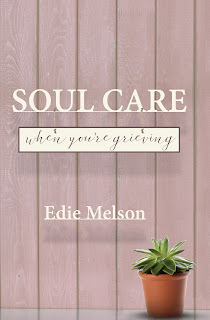 Soul Care When You're GrievingEdie Melson
Soul Care When You're GrievingEdie MelsonThere is no right or wrong way to face loss. But do you ever feel you could be coping better?
Grief is difficult. We all experience it-and we experience it differently. But what if you could break down some of the barriers created by grief? What if you could latch onto ways to engage again with the world around you?
It's far too easy to be tied to common misconceptions about grief. By reframing those misconceptions, we can learn to give ourselves more grace as we process loss. Each chapter of Soul Care When You're Grieving is designated by the opposite of one of the five experiences of grief and can help you start that course to reframing through:devotionsprayerscreative exercises
God designed you uniquely—including how you process loss. Learn to embrace your own personal blueprint for dealing with grief.
Publisher: Bold Vision BooksPaperback copy available at amazon.com
 Yvonne Ortega walks with a small footprint but leaves a giant imprint in people’s lives. This power-packed package is a professional speaker and the author of the Moving from Broken to Beautiful® Series through cancer, divorce, forgiveness, and loss. Learn more at WWW.YVONNEORTEGA.COM
Yvonne Ortega walks with a small footprint but leaves a giant imprint in people’s lives. This power-packed package is a professional speaker and the author of the Moving from Broken to Beautiful® Series through cancer, divorce, forgiveness, and loss. Learn more at WWW.YVONNEORTEGA.COMYvonne speaks with honesty and humor as she shares her life and struggles through presentations that empower women to find peace, power, and purpose through God’s Word.
Yvonne’s background as a licensed professional counselor brings a unique perspective into the heart of women. She’s a speaking and writing coach and the owner of Moving from Broken to Beautiful®, LLC. She belongs to the Advanced Writers and Speakers Association, the Christian Authors Network, the National Speakers Association, and Toastmasters International.
She celebrates life at the beach, where she walks, builds sand castles, blows bubbles, and dances.
Publisher: Bold Vision BooksPaperback copy available at amazon.comKindle version available at amazon.com
Published on April 29, 2022 22:00
April 28, 2022
14 Basic Tips for a Successful Book Signing
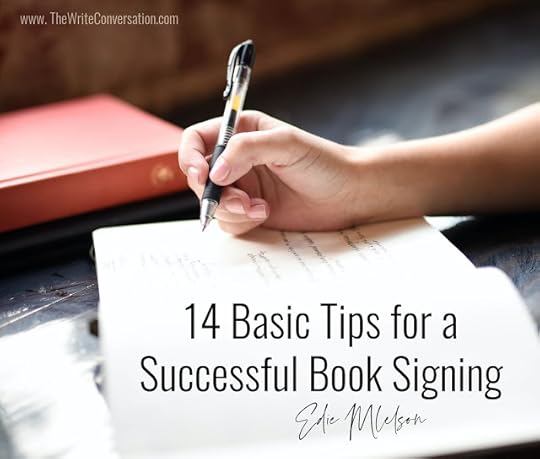
by Edie Melson @EdieMelson
Book signings . . .
For every want-to-be author they sound like a dream come true.
For those of us who have more than one book published . . . well . . . not always.
Whether you’re a seasoned author or just releasing your first book, there are certain things that can make you book signing successful and much less terror-inspiring.
Basic Tips for Book Signing Events
1. Make it an event. I’m speaking from experience here when I tell you that sitting behind a table with a stack of books, business cards, and a pen is a recipe for being ignored and disappointed. However, if you add some balloons, some friends, giveaways, and cupcakes (if allowed) people will come from all parts of the store to see what’s happening.
2. Don’t sit down. Don’t even let them bring you a chair, it’s just too tempting. Here’s why:It’s too easy to overlook you when you’re seated and below the customer or attendee’s line of site. It makes you look unapproachable.It makes it hard to interact and engage casual lookers.
3. Stand in front or beside your table of books. Hiding behind something may feel safer for those of us who are introverts, but the truth is you need to be inviting people to slow down chat.
4. Have something in your hand to give away. When you’re at your book signing, don’t go empty-handed. It could be bookmarks, a postcard, or even a short trivia quiz (more on what to DO in # 5). If you hand someone something, it begins a real connection.
5. Consider an activity. If you’re doing a book marriage, come up with a short, funny quiz for those who come near to take. If you’re sharing a children’s book, put together a short scavenger hunt. Give away a PDF of tips on how to pray for your kids, or a coloring page with a Bible verse. The ideas are endless, but giving people a way to interact with make them more likely to stop and buy a book.
6. Enlist your friends. We have a vibrant writing community here where I live (Greenville, SC) and I’m part of several writing groups. When it comes to book signings, we support each other. I encourage writers to support other writers by attending book signings because you want the same support when it’s your turn.
By asking friends and family to come by, it ensures a steady stream of visitors and helps make your book signing become an event as opposed to an interruption. I also arm those who come to support me with bookmarks and business cards and send them throughout the store. They can hand out the bookmarks and encourage those who haven’t talked to me to stop by and see what I’ve got.
7. Have a big giveaway or two. One thing I love to do is giveaway gift cards or certificates to the bookstore where I’m signing books. This helps the bookstore’s bottom line and your sales. And by big giveaway, I’m not talking hundreds of dollars, just something that’s actually worth money.
8. Have a way to subscribe to your email list. For someone to enter the drawing, I ask them to enter their name and email on my iPad (or computer) and subscribe to my mailing list. If someone refuses to do that, I still let them enter (it’s the nice thing to do) but I don’t have many who balk at sharing email for a change to win a prize.
I don’t use written slips of paper because they’re hard to read after I get home and I get a lot of unsubscribes if they don’t actually enter their own names.
9. Enlist an assistant. If you're expecting a good sized-crowd find someone to help you manage the line. Provide small squares of paper for those in line to print their names on. This will help you with spelling.
10. Invest in several good pens. Every author has their favorite type. I'm partial to signing with a Sharpie brand. Just make sure the ink won't smudge.
11. Announce the book signing in advance. I utilize social media, email and to friends and family. This is when I can share what the “Grand Prize” will be for attending.
12. Consider an online component. Since I’m already sharing the event on social media, I add a second big prize that I draw from those who share about the event on social media. I use RaffleCopter to do that so I don’t break any rules on the various social media platforms.
In addition, see if you have a friend who will share pictures and maybe a short video of your book signing while it’s going on. That allows those who can’t attend to enjoy it vicariously.
13. Be aware of what you can and can’t do. Depending on where your book signing is, there may be some guidelines you need to follow. In a bookstore, they may or may not allow food and drink. If you’re at a restaurant, there may be other guidelines. Find out the rules and follow them. That will ensure getting asked back!
14. Don’t forget to thank the host. If you’re signing at a book store, bring some cookies or something to leave with them after the event is done.
These are my dozen basic tips to make a book signing successful. I’d love to know what you’d add to this list?
Don’t forget to join the conversation!Blessings, Edie
TWEETABLE14 Basic Tips for a Successful Book Signing from @EdieMelson (Click to Tweet)
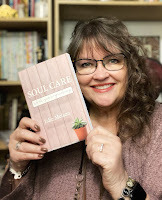 Edie Melson is a woman of faith with ink-stained fingers observing life through the lens of her camera. No matter whether she’s talking to writers, entrepreneurs, or readers, her first advice is always “Find your voice, live your story.” As an author, blogger, and speaker she’s encouraged and challenged audiences across the country and around the world. Her numerous books reflect her passion to help others develop the strength of their God-given gifts and apply them to their lives. Connect with her on her website, through Facebook, Twitter, and Instagram.
Edie Melson is a woman of faith with ink-stained fingers observing life through the lens of her camera. No matter whether she’s talking to writers, entrepreneurs, or readers, her first advice is always “Find your voice, live your story.” As an author, blogger, and speaker she’s encouraged and challenged audiences across the country and around the world. Her numerous books reflect her passion to help others develop the strength of their God-given gifts and apply them to their lives. Connect with her on her website, through Facebook, Twitter, and Instagram.Featured Image: Photo by Hannah Olinger on Unsplash
Published on April 28, 2022 22:00



